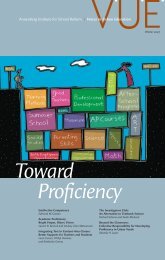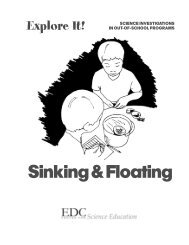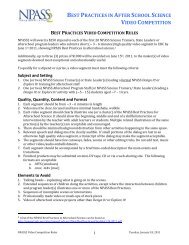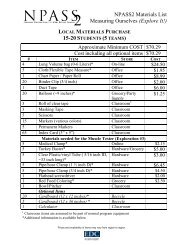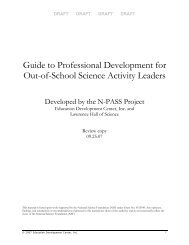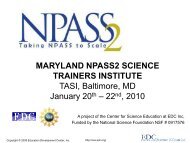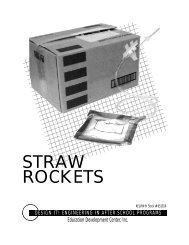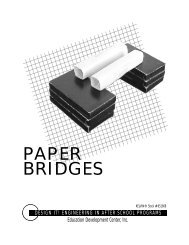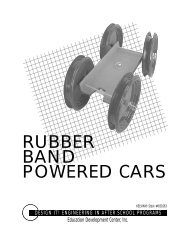EDC Cake Chemistry - NPASS2
EDC Cake Chemistry - NPASS2
EDC Cake Chemistry - NPASS2
Create successful ePaper yourself
Turn your PDF publications into a flip-book with our unique Google optimized e-Paper software.
MAKING UP YOUR OWN RECIPEEXPLORATION 1RATIONALECooking is a very popular activity with children. It offers opportunities to get at some basicscience in a tasty way. The first part of the exploration is more about design than inquiry. Thegoal for the children is to come up with a workable recipe. This necessarily involves some trialand error and some experimenting. With minimal coaching, they can come up with somethingthat may not be a terrific cake but is good enough for eating.While working with the recipes, children have to think about the proportions of eachingredient and, in doing so, are working with practical math. Ratios and proportions arechallenging relationships to understand, so giving children the opportunity to make a recipe willhelp them see how these relationships can be applied to real-life situations.The second part of the exploration, involving testing the different ingredients, is moreclosely related to the scientific process. It is especially so if done in a systematic manner assuggested by the use of a grid (or matrix). The activity opens with the general question, “Whatmakes the cake rise?” As scientific sleuths, children carry out some different tests to find outwhich ingredient in different recipes causes cakes and breads to rise, and how this ingredientbrings about this effect.SCIENCE/TECHNOLOGY BACKGROUNDComing up with a recipe for a cake is in some ways like trying to find the right combinationof ingredients to bring about a chemical change. If the proportions are just right, you will get thechemical product you want (i.e., the cake will be edible).Some of the cakes may collapse. There are a number of reasons why this may happen:• The recipes may have too much liquid.• There may be too much baking powder.• There may not be enough egg.After they have tasted their results, you may want to mention one point. In regular cakerecipes, the amount of baking powder is very small compared with the total amount of wet anddry ingredients. For example, for 2 cups (total) of flour and sugar, it is suggested that only 1 or 2teaspoons of baking powder be used. What does this suggest for the amount of baking powderchildren should use in their own recipes, considering they use no more than 15 spoonfuls offlour? This can be a way of thinking about proportionality.At this point, it may not be readily apparent to the children why baking powder is used. Youcan try to discuss with them what would happen if it was not added to the ingredients. From thetesting in Part 2, they saw that it fizzes with milk, making bubbles. You can point out that thewet flour is now dough—a clump of something that can be stretched. If bubbles form inside thisstretchy mass, they can cause it to grow or expand.OBSERVING PROGRESSThe first exploration of this project provides an important occasion for establishing abenchmark by which you can get a sense of what children are getting out of the series ofexplorations. In most of the activities within this project, children will be measuring ingredientsand carrying out operations that require the development of fine motor skills. During the firstexploration, observe and listen closely to how the children are working with the materials andhow they talk about what they are discovering and observing.1EXPLORERS’ SHEET1GUIDING THE EXPLORATION1BACKGROUNDExplore It!11



